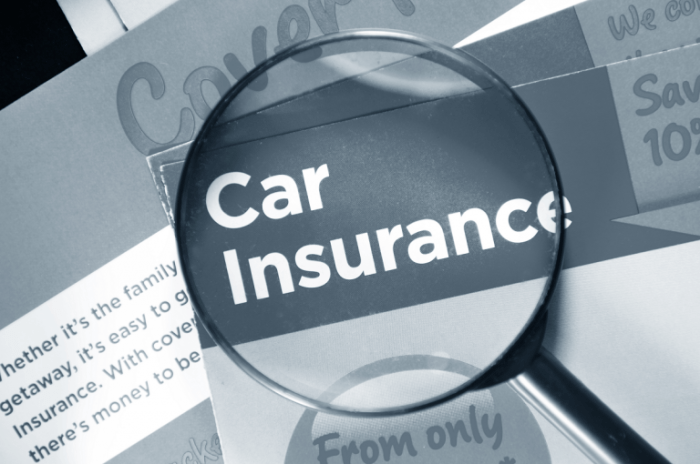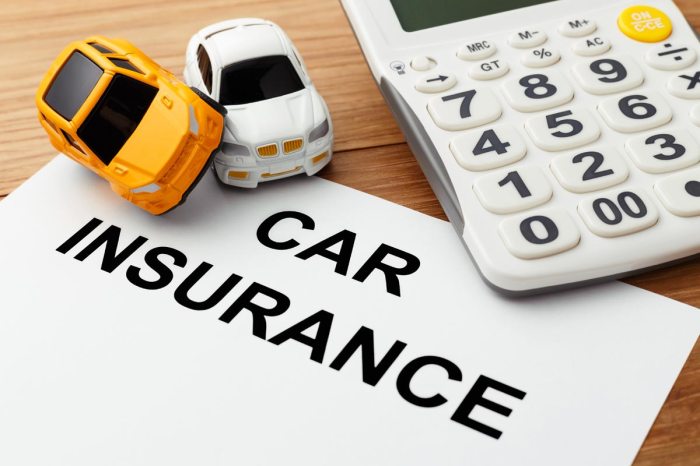Securing the right car insurance is crucial for every car owner. This guide delves into the complexities of car insurance, offering a clear understanding of coverage types, factors influencing premiums, and strategies for finding the best deals. We’ll explore the nuances of different policy options, helping you make informed decisions to protect your vehicle and your financial well-being.
From understanding liability and collision coverage to navigating the intricacies of your insurance policy and finding the most affordable rates, this resource provides a comprehensive overview of the car insurance landscape. We’ll examine how your driving history, vehicle type, and location all play a role in determining your premium, empowering you to take control of your insurance costs.
Types of Car Insurance Coverage

Choosing the right car insurance can feel overwhelming, but understanding the different types of coverage available is crucial for protecting yourself and your vehicle. This section will clarify the key differences between common coverage options, the factors influencing their cost, and situations where each type proves beneficial.
Liability Coverage
Liability insurance covers damages or injuries you cause to others in an accident. It typically includes bodily injury liability and property damage liability. Bodily injury liability pays for medical expenses and other damages incurred by the other party. Property damage liability covers repairs to the other person’s vehicle or property. The cost of liability coverage is influenced by factors such as your driving record (accidents and tickets), your location (higher crime rates generally mean higher premiums), and the amount of coverage you choose (higher limits cost more). For example, if you cause an accident resulting in $50,000 in medical bills for the other driver and $10,000 in damage to their car, your liability coverage would pay for these expenses, up to your policy limits.
Collision Coverage
Collision coverage pays for repairs to your vehicle regardless of fault in an accident. This means even if you caused the accident, your insurance will cover the cost of fixing your car, minus your deductible. Factors influencing the cost of collision coverage include the make and model of your car (luxury cars are more expensive to repair), your deductible (higher deductibles mean lower premiums), and your driving record. For instance, if you hit a tree, your collision coverage would help pay for the repairs, subject to your deductible.
Comprehensive Coverage
Comprehensive coverage protects your vehicle from damage caused by events other than collisions, such as theft, vandalism, fire, hail, or natural disasters. The cost of comprehensive coverage is affected by similar factors as collision coverage, including the value of your vehicle and your deductible. For example, if a tree falls on your car during a storm, comprehensive coverage will help pay for the repairs.
Uninsured/Underinsured Motorist Coverage
Uninsured/underinsured motorist (UM/UIM) coverage protects you if you’re involved in an accident caused by a driver who is uninsured or whose insurance coverage is insufficient to cover your damages. This coverage can pay for your medical bills, lost wages, and vehicle repairs. The cost of UM/UIM coverage is influenced by the amount of coverage you choose and your location. If an uninsured driver hits your car, causing significant injuries and property damage, your UM/UIM coverage would step in to help cover your losses.
Comparison of Car Insurance Coverages
| Coverage Type | What it Covers | Factors Affecting Cost | Example |
|---|---|---|---|
| Liability | Damages you cause to others | Driving record, location, coverage limits | Paying for another driver’s medical bills after an accident you caused. |
| Collision | Damage to your car in an accident, regardless of fault | Vehicle value, deductible, driving record | Repairing your car after a fender bender. |
| Comprehensive | Damage to your car from non-collision events | Vehicle value, deductible, location | Replacing your car after it’s stolen. |
| Uninsured/Underinsured Motorist | Damages caused by an uninsured or underinsured driver | Coverage limits, location | Covering your medical bills after being hit by an uninsured driver. |
Finding the Best Car Insurance Deal

Securing affordable car insurance requires a strategic approach. Finding the best deal involves comparing options from various providers and understanding the factors influencing your premium. This process can seem daunting, but with a systematic approach, you can significantly reduce your annual costs.
Several methods exist for finding affordable car insurance, each with its advantages and disadvantages. Online comparison tools offer a convenient way to quickly gather quotes from multiple insurers, while working directly with insurance agents allows for personalized guidance and potentially access to exclusive deals. The optimal approach depends on individual preferences and comfort levels with technology and independent research.
Comparing Online Comparison Tools and Insurance Agents
Online comparison websites aggregate quotes from numerous insurance providers, allowing for side-by-side comparisons based on your specific needs. This method is efficient and provides a broad overview of market pricing. However, the information presented might be limited, and personalized advice is generally not available. Conversely, working with an insurance agent provides a more personalized experience. Agents can explain policy details, offer tailored recommendations, and often have access to exclusive deals or discounts not readily available online. The trade-off is that this method may require more time and effort, as you’ll need to schedule appointments and potentially deal with more complex communication.
Negotiating Lower Premiums
Negotiating lower premiums is a viable strategy to reduce your insurance costs. Several tactics can be employed. First, shop around and use quotes from competing insurers as leverage during negotiations. Highlighting a lower quote from another provider can often incentivize your current insurer to offer a better rate. Second, explore ways to improve your driving record. Maintaining a clean driving history, including avoiding accidents and traffic violations, significantly impacts your premium. Third, consider bundling your car insurance with other policies, such as homeowners or renters insurance, as insurers often offer discounts for bundled coverage. Finally, inquire about discounts based on your vehicle’s safety features, your occupation, or any affiliations you might have (e.g., professional organizations).
Obtaining Car Insurance Quotes from Multiple Companies
A step-by-step guide to obtaining car insurance quotes is crucial for securing the best deal. First, gather necessary information, including your driver’s license, vehicle information (make, model, year), and driving history. Second, utilize online comparison tools to generate quotes from multiple insurers. Third, contact insurance agents directly to discuss your needs and obtain personalized quotes. Fourth, compare all quotes carefully, paying close attention to coverage details, deductibles, and premiums. Finally, choose the policy that best meets your needs and budget, considering the balance between coverage and cost. Remember to thoroughly read the policy documents before signing.
Car Insurance and Driving Habits

Your driving habits significantly influence your car insurance premiums. Insurance companies assess risk, and safer driving translates to lower costs. Understanding this connection empowers you to make informed decisions about your driving and potentially save money on your insurance.
Safe driving practices demonstrably reduce the likelihood of accidents, a key factor in determining insurance rates. By adopting a proactive approach to safety, you can minimize your risk profile and enjoy lower premiums.
Safe Driving Practices and Insurance Premiums
Implementing safe driving practices is a straightforward way to influence your insurance costs. Consistent adherence to traffic laws, defensive driving techniques, and regular vehicle maintenance all contribute to a lower risk profile, leading to potential savings. For example, avoiding speeding tickets and maintaining a clean driving record demonstrably reduces the likelihood of accidents and subsequent claims, thereby lowering your insurance premium. Similarly, proactive vehicle maintenance, such as regular tire rotations and brake checks, minimizes the risk of mechanical failures that could lead to accidents. Defensive driving, encompassing practices like maintaining a safe following distance and anticipating potential hazards, further reduces the chance of accidents.
Telematics Programs and Their Impact on Insurance Costs
Telematics programs, also known as usage-based insurance (UBI), utilize technology to track driving behaviors. These programs typically involve installing a device in your vehicle or using a smartphone app to monitor aspects such as speed, acceleration, braking, and mileage. Data collected is then used to assess driving habits, and premiums are adjusted accordingly. Drivers exhibiting safer driving patterns, characterized by consistent adherence to speed limits and avoidance of harsh braking or acceleration, often qualify for discounts. Conversely, risky driving behaviors can lead to higher premiums. For example, a telematics program might reward a driver who consistently maintains a speed below the limit with a discount of 10-15% on their annual premium, while a driver frequently exceeding the speed limit might face a premium increase of a similar percentage. The specific impact varies based on the insurer and the program’s design.
Consequences of Driving Violations on Car Insurance Rates
Driving violations directly impact car insurance rates. Insurance companies view violations as indicators of increased risk. The severity of the violation and the driver’s history influence the impact on premiums. For instance, a speeding ticket might result in a moderate premium increase, while a more serious offense, such as driving under the influence (DUI), could lead to a significantly higher premium or even policy cancellation. Multiple violations within a short period will generally result in even steeper increases. The increased cost reflects the heightened risk associated with drivers who have demonstrated a pattern of unsafe behavior. For example, a first-time speeding ticket might lead to a 10-20% increase, while a second offense within a year could double that increase. A DUI conviction could easily result in a premium increase of 50% or more, depending on the insurer and the specifics of the offense.
Wrap-Up
Choosing the right car insurance can feel overwhelming, but with a clear understanding of the factors involved, you can make informed decisions to protect yourself and your vehicle. By comparing quotes, understanding your coverage options, and practicing safe driving habits, you can secure affordable and comprehensive car insurance that meets your specific needs. Remember to regularly review your policy and adjust it as your circumstances change to ensure you maintain adequate protection.
Q&A
What is the difference between liability and collision coverage?
Liability coverage pays for damages you cause to others, while collision coverage pays for damage to your own car, regardless of fault.
How often should I review my car insurance policy?
It’s advisable to review your policy at least annually, or whenever there’s a significant life change (e.g., new car, address change, change in driving habits).
Can I get my car insurance canceled?
Yes, your insurance can be canceled for various reasons, including non-payment of premiums, fraudulent claims, or serious driving violations. Check your policy for specifics.
What is a deductible?
A deductible is the amount you pay out-of-pocket before your insurance coverage kicks in. Higher deductibles usually result in lower premiums.
What happens if I’m in an accident and I’m at fault?
If you’re at fault, your liability coverage will pay for the other person’s damages. Your collision coverage will cover damage to your vehicle, minus your deductible.